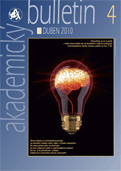Orkney voles repeal the path of the colonisers and the genetic ark

4 Sep 2013
An Exotic Conifer Helps Destroy Cancer Cells

9 May 2013
A discovery by Czech molecular geneticists
Some scientists compare the search for an effective medicine against cancer, which would besides the successful elimination of cancer cells if possible not have any, or at least minimal, side effects for the organism, to the search for the Holy Grail. Unlike Indiana Jones, who in the film The Last Crusade actually found the Holy Grail, the scientific community had not had such luck as of yet. A distinct shift towards this dreamt-of goal could be the discovery by researchers from the Institute of Molecular Genetics of the Academy of Sciences of the ASCR, which was published recently in the online version of the international journal Apoptosis (see the abstract).
Professor Antonín Holý, the discoverer of new antiviral drugs, has died

17 Jul 2012
Syncytin – dobrý sluha, ale zlý pán

24 Feb 2012
White Nose Syndrome: Can Czech Bats Help American Bats?

20 Jan 2012
An Article by Czech Scientists in the Journal of Wildlife Diseases
Scientists from Moravian workplaces have proved that bats here suffer from white-nose syndrome, a fungal disease that is threatening the ecosystem in North America. In the Czech Republic as well as in other parts of Europe, bats with this syndrome die only very rarely and the disease has not yet caused a decline in the population numbers. Uncovering the cause of ‘European immunity’ could save North American bats and avert also the disruption of the biological balance in that part of the world.
The Discovery of the Principle of Timing the Activation of Memories in the Brain

30 Sep 2011
Jednání o šlechtění pšenice v Paříži

16 Sep 2011
DNA decorated by attachment of other molecules
9 Jun 2010
Scientists from the Institute of Organic Chemistry and Biochemistry ASCR have developed a novel simple and efficient methodology for attachment of other molecules to DNA. They prepared DNA bearing very reactive chemical functional groups that can be readily (in one step) linked to diverse other molecules e.g. for studying of molecular mechanism of important biological processes or for labeling of DNA by color or electroactive markers. This methodology has a promising potential for a broad range of applications in interdisciplinary area between chemistry and biology.
CONDUCTING POLYMERS - Formation, structure, properties, and applications
9 Jun 2010
10–14 July 2011 - 75th Prague Meeting on Macromolecules be focused on the main topic - CONDUCTING POLYMERS - Formation, structure, properties, and applications. Characterization of conducting polymers by spectroscopic methods. Modelling and simulations. Molar masses and molecular architecture. Electrical, magnetic, mechanical, optical and other physical properties of conducting polymers.
Consequences of being rich: wealth and population are key drivers of invasive species in Europe

8 Jun 2010
A new study of biological invasions in Europe found they were linked not so much to changes in climate or land cover, but to two dominant factors – more money and more people. Wealth and population density, along with an increase in international trade and commerce, were the forces most strongly associated with invasive species that can disrupt ecosystems and cause severe ecological or agricultural damage, scientists said.





